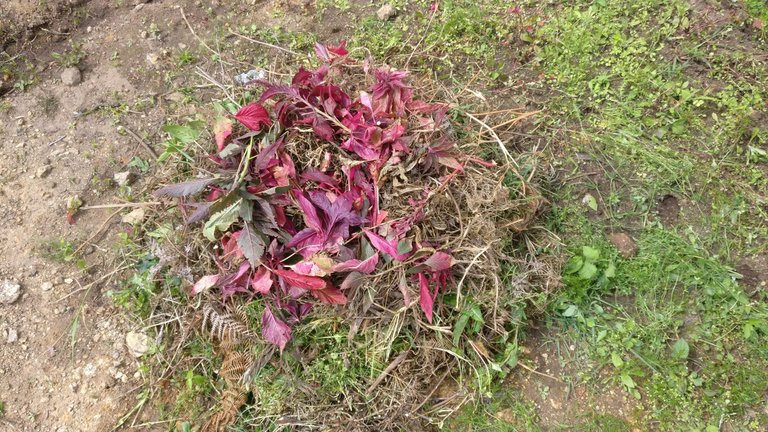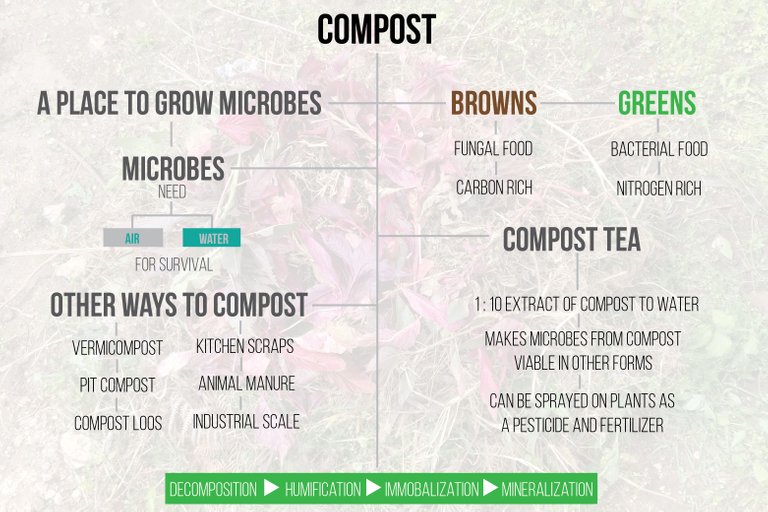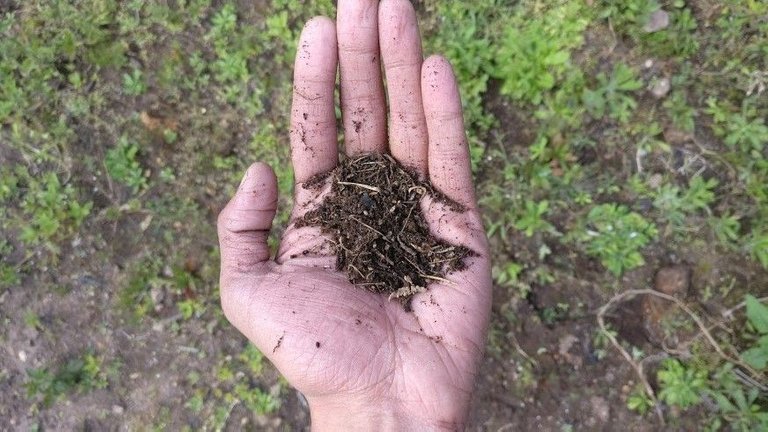
This post is about how I made our first batch of compost on our farm using one of the various compost making techniques.
Compost is a vital component for many homesteaders and organic farmers. It's a good fertilizer, packed with a lot of nutrients and minerals that enrich the soil, but its most important role is in introducing micro-organisms to the soil.
A lot of people don't realize that soil is not as inert as it seems to be.
Soil is alive!
Which is why they say a good farmer grows their soil before they grow their crops. The beauty of compost is that it completes a cycle. Dead plants decompose and provides nutrients for living plants. Unlike chemical fertilizers, the nutrients are broken down by micro-organisms that play a big role in soil health. They form a living network similar to the internet that help plants communicate and interact with each other. Plants that fix nitrogen in soil do so through a micro-organism called Rhizobium that attaches to their roots. It's quite fascinating how these minuscule living entities work. Some say we know more about the cosmos than the world of micro-organisms. The more alive your soil is, the better your crops will perform and compost is one of the key ways in building soil health and fertility.
In an attempt to grow our soil on the land, we made use of the organic material we had an abundance of, which in our case was leaves and weeds from our land and the adjoining forest. We used a variation of a simple technique to make our compost that can be finished in three easy steps and in less than a month.

Brown leaves and organic matter are rich in Carbon and provide food for fungi and fungal networks. Green leaves and organic matter are rich in Nitrogen and provide food for bacteria and micro-organisms. There are different opinions on the ratio of Brown:Green and Carbon:Nitrogen to be used in making compost and often depends on what crops/ land you want to use it for. I decided to use roughly equal amounts of each for an all purpose compost.
I start my compost pile with a layer of brown material. The twigs and sticks at the bottom allow more air to flow through the pile. After stacking layers of brown and green material, I add a layer of what's known as dynamic accumulators. They are plants that fix lesser known nutrients into the soil such as Calcium and Magnesium among others. A quick online search will show you which plants in your area are dynamic accumulators. The ones I used are Amaranth and Nasturnium. Putting them in the middle of your compost pile is believed to speed the process up, and adds more nutrients and minerals to the final compost resulting in a well balanced mix that has everything your plants could need. More layers are stacked on top of this layer till the pile is finished.

When the pile is um piled, water is sprinkled on top and the pile is covered with tarpaulin or similar material. The pile needs turning in intervals, meaning the pile needs to be mixed up. It can be done from the bottom to the top and from the outside to the inside. The idea is to mix your layers thoroughly to provide aeration to the pile. The pile is also sprinkled with water when it is turned. Microbes need air and water for survival, and this provides the best living conditions for them. Again, the frequency of turning depends on climate and other factors and it may take a while to find the right turning times for your location. In general it should be turned for the first time after 4-7 days and then every 3-4th day afterwards. This is a hot compost method, and you'll know the process is underway when you stick your hand in the middle and feel heat. The pile may even start steaming in cooler climates. Since we've provided our microbes with so much air and water through this process, they start thriving and the pile can be turned to compost in less than a month. The pile may reduce in size through the process as the days pass. After around three weeks, we're left with good quality compost that can be used on the field. Another way to make use of the compost is to make a compost tea which is a 1:10 mixture of compost to water. The liquid has all the beneficial microbes from the compost and can be applied on plants as a pesticide and fertilizer. It also promotes microbial growth on the plant itself and is a nice way to utilize your compost.

There is a lot more to compost and they way it works. This is just one of the ways you can make it using leaves. As our adventures on the homestead continue, we'll be sure to try out different methodologies and techniques. This pile was rather small and done on an experimental basis. In around a month we had some great compost to use which we spread around our trees. We'll soon be replicating the process on a larger scale and experimenting with different bio-ferments and compost techniques.

Composting is becoming more prominent even in cities and a lot of families including ours compost all our kitchen waste.
Have you made compost before, and what kind of techniques did you use?

| PAL-Minnow Support Project | Homesteaders Online |


















There is a lot of information on composting out there. But a lot of it starts of with something like “composting is so easy!!” and then goes on to explain an overly complicated process. I love the true simplicity and explaination in this post!
Haha, as I'm just starting my permaculture/homesteading adventures I relate to this. People make things seem so easy, but actually getting them done is so much harder. I learn by just trying and the mistakes I make along the way. Glad you found it easy to understand. Compost is quite a complicated subject, but I filtered out my understanding of it from my experience.
Fabulous article @soulturtle. We have a SUPER natural compost heap in our suburban backyard that's approximately 2 x 2 meters and well over a meter in height.
It's been made by a Brush Turkey who has ~ Without permission ~ Scratched and kicked off all the garden compost that I've been making for years and years, from all the dried leaves and clippings from the garden.
We tried to persuade him to leave but eventually had to concede to his natural instinct to build a nest for all the sweethearts he wanted to attract.
After about 4 months of watching the garden really suffer, through an especially dry summer with no mulch, he's about to leave. And we will now have the most amazing compost under the surface dried leaves because Brush Turkeys turn the pile just about every day and monitor the heat. Will have to take a photo of it for you. 🦋
I absolutely love this comment. How awesome is that? A turkey that makes your compost for you just because he's chosen to settle down in your land. He's built quite the pile in his time there! Is he a wild turkey?
Unfortunate that the garden is suffering. We're lucky to have enough water now but there have been dry spells when the monsoon just doesn't come, so I can relate. Hope your turkey returns when your garden is doing better and has the necessary enticements , but this time stays in a designated spot.
Yes, please send a photo. I'd love to see this magnificent compost making Brush Turkey.
Out of this whole mound came only one baby Brush Turkey. The baby flew way ~ I saw it the other day across the other side of the road and down a street. The Turkey bulder still visits every morning scratching around, looking for food but doesn't seem to worry too much that I'm taking the soil back to the garden again. It's fantastically composted soil now. But a lot of work to restore the garden. Most of the shallow rooted plants/green vegies didn't survive.
That's amazing. What a large pile for such a tiny bird. So great that he's still around and letting you do your thing. Love this photograph!
Great stuff! I have been working with building better and better compost with each new pile. This season I plan to plant a row of bocking 14 comfrey to be my main nitrogen input, and I'm working on a chipper to break up my carbon inputs into smaller pieces. And I have been nerding out on soil science like crazy lately. I definitely recommend reading anything by Dr.Ingham. Right now I'm absorbing JADAM, which really promotes anaerobic microbes over aerobic, which flies in the face of my composting methods. I'll have to write a post on my findings.
Great post about compost! I love seeing the updates!
Hey, Brett! Great to see you here.
I've read a lot about the benefits of comfrey near your swales but it doesn't seem to be available here. Got to find what out local equivalent is. Sounds like you've got a lot of awesome things going on. I haven't been doing too much research, but try and learn by trying out various methods. Looking forward to learning from your experiences and those awesome posts I'm sure you'll write.
Steemit takes some time to get used to, but is a great place to be. There's a thriving homesteading/ permaculture community here and I'm glad you're here to share your insights with us.
I really appreciate that, Kartik! You're right, steemit does take some getting used to, but I see a lot of potential here for sharing content.
Your post has been featured in this week's earth-centered curation @the-hearth.
Thanks for writing such fantastic and inspiring content!
Wow, thank you for the feature! So great to know my content is appreciated :)
your content is so appreciated @soulturtle <3
This is all new to me!
A Londoner and true city dweller for my first 36 years I have been moving towards off grid living and low level homesteading for some while now.
Am soon to move to Bulgaria and get some real dirt under my fingernails so your post is most informative ~ thanks.
I am an artist/writer/lightworker so I get your more more spiritual posts too :)
Glad to have bumped into you here ~ upvoted/followed I invite you to pop by mine if you have a spare moment between composting!
With Love.
xox
I've been a city slicker too. We've also got a lot to learn, but there's something so empowering about tapping into Earth's magic and beauty too.
Hope my experience helps with your adventures in Bulgaria. Do share when you get to it!
I love the term lightworker. Sounds very intriguing. I'll be sure to drop by your blog too!
I am still (staying) in cities but - as I am picturing myself living a (mostly) self sustaining life and I am slowly making my way towards Portugal - I need to start reading up on this kind of themes. Thanks for sharing such an extensive explanation!
P.S. Why wasn't I following you yet? I feel I missed a lot of good stuff :>)
That's the nice thing about compost. You can do it anywhere! Good luck with your travel adventures and an off grid life in Portugal. It sounds amazing and I'm happy to have inspired you.
Haha, well the posts are on the blockchain forever so you haven't really missed out.
Nice read. Only the compost pile needs to be at least 10 times bigger otherwise you don't built up enough heat to get the composting going fast!
Yeah, this was just an experiment to see how it works. We still got some good compost from it, but not enough for all our plants. Valid point on having a larger pile. Definitely gonna be continuing composting and bio-fermenting adventures on a larger scale in the future!
I’ve built mine with three wooden pallets and a wall. One on the ground against the wall, this allows the air to come from under and two on each side. I used tarp on the sides because they had some of the boards removed, but I have since replace the pallets
Whoooa, what a beautiful looking system. Pallets seem to have so many uses! How long does it take for your material to compost?
I usually pre-compost horse manure and then give them to the worms. So it takes up to two weeks. I first pile up and let it heat to at least 131F for at least 3 days, then I turn the pile and water it down and let it heat up again.
I don’t have enough other material for compost and the leaves in my garden are used for mulching. For compost I use the worms.